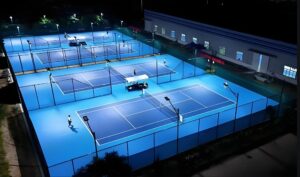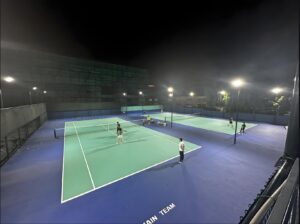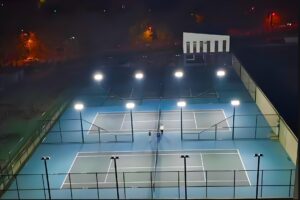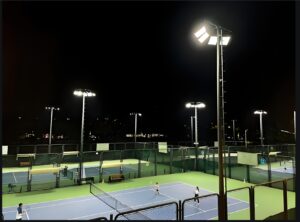I. Introduction
Overview of LED Sports Lighting
Importance of lighting in sports, particularly tennis
Lighting plays a critical role in sports, particularly in tennis, where fast-paced action and precision are key elements of the game. The quality of lighting affects both the athletes’ performance and the overall viewing experience for audiences, whether in the stadium or watching from home. Here’s why lighting is so crucial in tennis:
- Player Performance
- Visibility of the Ball: In tennis, players must be able to track a fast-moving ball that can travel at speeds exceeding 200 mph. Proper lighting ensures that players can clearly see the ball from the moment it leaves their opponent’s racquet, throughout its trajectory, and as it approaches them for a return. Poor lighting, such as dark spots or glare, can cause players to misjudge the ball, affecting the quality of play.
- Court Visibility: Players need to have a clear view of the lines, surface, and other players. Uneven or dim lighting can create shadows that obscure these critical features, leading to unfair conditions and decreased player confidence. Uniform lighting ensures that the entire court is well-lit and visible from every angle, promoting fairness and consistency.
- Broadcasting and Viewer Experience
- Television and Streaming Quality: Tennis matches are broadcast to millions of viewers worldwide. Poor lighting can result in blurry or overexposed footage, making it difficult for the audience to follow the action. Bright, uniform lighting enhances picture quality, allowing cameras to capture crisp, clear visuals of the ball, players, and the surrounding environment.
- Color Accuracy: Tennis has bright, colorful elements—especially the ball, which is typically a fluorescent yellow-green. Accurate color reproduction is important for a realistic viewing experience. Proper lighting ensures that viewers can clearly distinguish the ball from the background and other court elements.
- Lighting for Night Matches: For evening and night matches, lighting becomes even more critical. Matches like those at Wimbledon, which may be played late into the evening, require consistent and high-intensity lighting to ensure that the players’ visibility is not compromised by fading daylight. LED lights, in particular, excel in this regard by offering high lumens per watt, ideal for maintaining brightness over extended hours.

- Safety and Comfort
- Reduced Eye Strain: Tennis requires intense focus, and players need to be able to quickly adjust to changes in light intensity, especially when moving between shaded and brightly lit areas of the court. Flickering lights, uneven illumination, or excessive glare can lead to eye strain, distracting players and potentially causing injury. Well-designed lighting systems eliminate such issues, allowing players to maintain focus and perform optimally.
- Player Comfort: Lighting should be uniform and free of hot spots. Sudden changes in light intensity or glare from poorly positioned lights can be disorienting. Players need to feel comfortable and confident under ideal lighting conditions to focus on the match without worrying about visual distractions.
- Fairness and Regulation
- Compliance with Regulations: Professional tennis events, such as the Grand Slam tournaments, must adhere to strict lighting standards set by governing bodies like the International Tennis Federation (ITF). These standards ensure that the lighting is sufficient for fair play and consistent visibility for all players and officials. Adequate lighting levels (typically a minimum of 1500 lux for high-level play) are required to avoid any advantage being gained due to visibility issues.
- Consistent Playing Conditions: The lighting conditions must be the same for both players to ensure fairness. If one player is subject to glare or poor visibility, it could disrupt the balance of the game. A properly lit court ensures that all participants are on an equal footing, regardless of the time of day or weather conditions.
- Aesthetic Appeal and Atmosphere
- Creating an Exciting Atmosphere: Lighting not only serves a functional purpose but also contributes to the atmosphere of the event. Bright, focused lighting can add to the excitement, particularly during night matches, enhancing the drama of key moments and making the match more visually engaging for spectators in the stadium and on television.
- Showcasing the Venue: Lighting highlights the beauty and design of the venue. Proper lighting brings out the details of the court surface, the stadium seating, and the surrounding areas, creating a visually striking backdrop that complements the action on the court.
In conclusion, lighting is not merely a secondary consideration in tennis but a fundamental part of the game. Proper lighting enhances player performance, ensures safety, contributes to the viewer experience, and upholds fairness in the competition. For high-profile events like Wimbledon, where every aspect of the game is scrutinized, the role of lighting becomes even more pronounced, making it an integral part of a professional tennis match.

Brief introduction to LED technology and its rise in sports venues
LED (Light Emitting Diode) technology has revolutionized the way lighting is used across various industries, including sports. Unlike traditional lighting sources, such as incandescent and fluorescent bulbs, LEDs generate light by passing an electric current through a semiconductor, which emits light. This process is highly efficient, resulting in energy savings, longer lifespans, and a lower environmental impact.
In sports venues, lighting quality is paramount, especially for high-speed, high-intensity games like tennis, where visibility is crucial for both players and spectators. Traditional lighting systems often suffer from issues like slow warm-up times, inconsistent brightness, and short lifespans, which makes them less suitable for modern sports venues. In contrast, LED technology provides an instant-on feature, exceptional durability, and the ability to deliver bright, uniform light without flickering or heat buildup.
As a result, LED lighting has gained rapid adoption in sports arenas and stadiums around the world. From football fields to tennis courts, LEDs offer improved performance in a range of sports lighting applications. They allow for better control over light direction and intensity, ensuring that every corner of the playing surface is evenly illuminated. Furthermore, LEDs offer significant energy savings compared to older technologies, making them an attractive option for venues looking to reduce operating costs and their environmental footprint.
The transition to LED lighting in sports venues has been driven not only by the growing demand for sustainability but also by advancements in technology that allow for more precise, customizable lighting. Today, LED lighting is not only a functional necessity but a critical aspect of creating an engaging, visually appealing atmosphere for both live audiences and broadcast viewers.

Purpose of the article: Exploring how LED lighting meets the standards for prestigious tennis events like Wimbledon
The purpose of this article is to explore the crucial role of LED lighting in meeting the strict standards set for prestigious tennis events, such as Wimbledon. As one of the most iconic tennis tournaments in the world, Wimbledon demands lighting systems that ensure optimal visibility, fairness, and performance under a variety of conditions. This article will examine the key characteristics of LED lighting and how these features align with the rigorous requirements of top-tier tennis competitions.
By highlighting the benefits of LED technology—such as energy efficiency, durability, uniform light distribution, and precise control—this article will demonstrate why LED lights are becoming the preferred choice for tennis tournaments worldwide. In particular, we will focus on how LED lighting addresses specific needs in tennis, including proper lux levels, glare reduction, flicker-free operation, and color accuracy. Additionally, we will discuss how LED lighting systems help to enhance both player performance and viewer experience, whether in the stadium or through televised broadcasts.
Through this exploration, the article aims to provide a comprehensive understanding of why LED lighting is integral to maintaining the high standards of lighting required for events like Wimbledon, contributing to the overall success and professionalism of modern tennis competitions.
II. Key Characteristics of LED Sports Lighting
Energy Efficiency
How LED lights reduce power consumption compared to traditional lighting systems
LED lights are known for their energy efficiency, which makes them an excellent choice for lighting applications across various industries, including sports venues. When compared to traditional lighting systems, such as incandescent or halogen lamps, LED lights significantly reduce power consumption due to several key factors:
- Higher Luminous Efficiency
- Energy Conversion: LED lights convert a much higher percentage of electrical energy into light, as opposed to traditional lighting technologies. Incandescent and halogen bulbs, for instance, produce a significant amount of heat in addition to light, making them much less efficient. In contrast, LEDs generate minimal heat and focus most of their energy on producing light. As a result, LEDs can provide the same level of brightness as traditional lights while using only a fraction of the energy.
- Example: A typical 100W incandescent bulb may only produce about 1600 lumens of light, while an LED bulb of equivalent brightness may use only 10-15 watts to produce the same amount of light.
- Longer Lifespan
- Fewer Replacements: LEDs have an average lifespan of 50,000 to 100,000 hours, compared to just 1,000 hours for incandescent bulbs or 2,000-4,000 hours for halogen lamps. With such a long lifespan, LED lighting systems require fewer replacements, reducing both maintenance costs and energy used in manufacturing and disposing of old lights.
- Reduced Operational Costs: Fewer replacements mean that venues don’t have to continually invest in new lighting fixtures or pay for the labor associated with maintenance, further driving down overall power consumption.

- Lower Power Demand
- Low Wattage for High Output: LEDs produce a higher amount of light (lumens) per watt of energy consumed compared to traditional lighting systems. This high luminous efficacy allows venues to use lower wattage LEDs to achieve the same brightness as much higher wattage incandescent, halogen, or metal halide lamps. Consequently, less power is required to achieve the desired lighting levels, reducing energy consumption and operational costs.
- Example: A 2000W metal halide lamp may be replaced with a 1000W or even a 500W LED, while maintaining the necessary lighting output for high-level tennis matches.
- Instant On/Off and Dimming Capabilities
- No Warm-Up Time: Unlike traditional lighting systems such as metal halide or high-pressure sodium lamps, which require several minutes to warm up and reach full brightness, LEDs provide instant lighting at full intensity. This feature is especially useful in sports venues where lighting needs to be adjusted quickly and efficiently without wasting energy during warm-up times.
- Dimming and Controlling Light Levels: LEDs offer excellent control over light intensity. In sports venues, lighting levels can be adjusted for different events or times of day, ensuring that only the necessary amount of light is used, further reducing energy consumption. Dimming capabilities allow venues to tailor lighting needs to match the specific demands of a given event, preventing unnecessary power usage.
- Directional Lighting and Reduced Waste
- Targeted Light Distribution: One of the key benefits of LEDs is their ability to direct light exactly where it is needed. Traditional lighting systems, such as floodlights, often produce a significant amount of light spill, which results in wasted energy and unwanted light pollution. LEDs, on the other hand, can be precisely directed, ensuring that the light only covers the areas of the court, reducing unnecessary energy expenditure on surrounding areas.
- Efficient Use of Power: With focused, directional lighting, LEDs maximize the impact of every watt of energy used, ensuring that power is not wasted in areas where light is not needed.
- Sustainability and Environmental Impact
- Lower Carbon Footprint: Because LEDs consume less energy, they also produce fewer carbon emissions compared to traditional lighting systems. In an era where sustainability is a key consideration, this reduction in energy use helps sports venues meet environmental goals and reduce their carbon footprint.
- Recyclability: LEDs are also more environmentally friendly when it comes to disposal. Traditional lighting systems often contain hazardous materials like mercury, which require special handling. LEDs, however, are free from such substances and are easier to recycle, further contributing to sustainability.
(To Be Continued)



